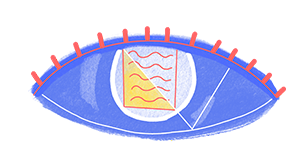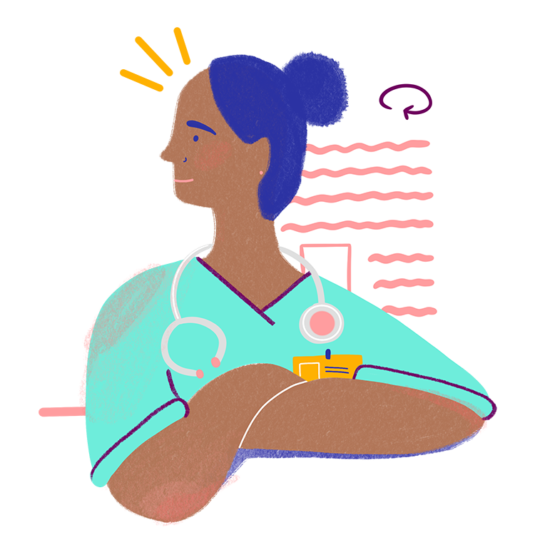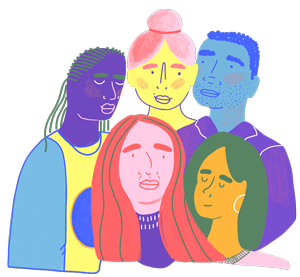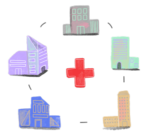Para Español haga click aquí (for Spanish click here).
What is OurDX?
 OurDX stands for “Our Diagnosis.” The letters “DX” are used by healthcare providers to mean “diagnosis”.
OurDX stands for “Our Diagnosis.” The letters “DX” are used by healthcare providers to mean “diagnosis”.
OurDX is a program studying whether the information that you share in a pre-visit survey helps you and your healthcare provider prepare for the visit, understand your main health concerns, and what matters most to you.
You can use OurDX to:
- Write your main goals for the medical visit (what matters most to you)
- Share updates about your health, such as your symptoms or main concern
- Describe any possible problems you have recently experienced in your care related to your main concern, such as wrong information in your medical record, miscommunication, or not being able to schedule a test or follow-up appointment
If you have new symptoms or health concerns, the information you share in OurDX may help your provider more quickly find the explanation for your symptoms or diagnosis. This is important so that your provider can give you the right treatment as quickly as possible.
OurDx is voluntary, and takes just a few minutes to complete.
When will my healthcare provider read my comments in OurDX?
 When possible, your healthcare provider will review your completed OurDX comments before or during your visit.
When possible, your healthcare provider will review your completed OurDX comments before or during your visit.
Sometimes your provider will not be able to review your responses immediately after you submit them.
If you have an urgent issue, contact your provider directly. When you arrive at your visit please remind your healthcare provider that you completed the pre-visit survey, in case they did not have the opportunity to read it.
Who will see my comments and what will my healthcare provider do with the information?
 Your comments will be stored in your medical record. Your healthcare provider may read what you wrote before or during your visit, and they may also include your comments in their own note about the visit in the medical record.
Your comments will be stored in your medical record. Your healthcare provider may read what you wrote before or during your visit, and they may also include your comments in their own note about the visit in the medical record.
If you do not keep your appointment, your healthcare provider may not read your comments. Your medical record can be viewed by other healthcare providers involved in your care.
Some of your comments in the survey may be used to help teach healthcare providers about what matters most to patients and how to improve partnering with patients and families in their care. If your comments are used for this purpose, they will be shared without your name or any identifying information.
Why am I only able to fill out OurDX for some of my healthcare providers, and not all?

Not all healthcare providers are currently participating in the OurDX program.
You will receive an invitation to complete the pre-visit form for any healthcare provider who is currently using OurDX. We hope to expand this program in the future!
What is the best way to describe my health concerns in OurDX?
 When describing health concerns several specific details can help, such as:
When describing health concerns several specific details can help, such as:
- What your symptom feels like
- When you feel the symptom
- What activities make the symptom feel worse
- Where it is located
- How long it lasts
- What makes it better or worse, including any treatments you have already tried
Clinicians also want to know about tests or visits you had related to this problem at other healthcare centers. The OurDX questions can help guide you.
Learn more about the role patients and families play in the diagnostic process:
What is a diagnosis?
 A diagnosis is an explanation for a patient’s symptoms. Your healthcare provider may use different kinds of information to make a diagnosis. These may include: your health history, a physical examination, tests (such as blood tests, X-rays or other imaging, or biopsies), and follow up appointments (such as a referral to see a specialist).
A diagnosis is an explanation for a patient’s symptoms. Your healthcare provider may use different kinds of information to make a diagnosis. These may include: your health history, a physical examination, tests (such as blood tests, X-rays or other imaging, or biopsies), and follow up appointments (such as a referral to see a specialist).
Making the right diagnosis in a timely manner depends on patients and healthcare providers working together as a team.
Not every visit involves a new diagnosis. For example, a “well visit” may involve talking about ways to stay healthy. An "educational visit" such as a consultation before a surgery may focus on what to expect after the surgery. However, new or worsening symptoms often involve a new diagnosis. Even patients who already have an existing diagnosis (such as asthma, diabetes, or inflammatory bowel disease) may experience changes that involve a new explanation (such as flu, strep throat, or arthritis).
How do patients and providers work together to reach a diagnosis?
 The diagnostic process is the set of steps you (as a patient or family member) and your healthcare providers take to find out what is causing your symptoms. It starts with you telling the healthcare provider about the symptom(s) and other details about your medical history. Healthcare providers listen and usually do a physical examination to see whether there are any signs of illness. Sometimes your healthcare provider will order tests or ask you to see a specialist, in order to come up with the most likely explanation for your symptoms—the “diagnosis.” Each step, starting with you first telling the healthcare provider about your symptom(s), to the provider reaching the final diagnosis and communicating it to you in a way you understand, is part of the diagnostic process.
The diagnostic process is the set of steps you (as a patient or family member) and your healthcare providers take to find out what is causing your symptoms. It starts with you telling the healthcare provider about the symptom(s) and other details about your medical history. Healthcare providers listen and usually do a physical examination to see whether there are any signs of illness. Sometimes your healthcare provider will order tests or ask you to see a specialist, in order to come up with the most likely explanation for your symptoms—the “diagnosis.” Each step, starting with you first telling the healthcare provider about your symptom(s), to the provider reaching the final diagnosis and communicating it to you in a way you understand, is part of the diagnostic process.
Will I get a diagnosis at the end of my visit?
 Some diagnoses are easier to make and may be clear to your provider right away. Others require more time and testing. Healthcare providers use new information as it becomes available to update your diagnosis. For example, information from test results, changes in symptoms, and whether you get better with a specific treatment, help your provider test and adjust the diagnosis as needed. It may take more than one visit to reach the final diagnosis, and the final diagnosis may be different from the first one.
Some diagnoses are easier to make and may be clear to your provider right away. Others require more time and testing. Healthcare providers use new information as it becomes available to update your diagnosis. For example, information from test results, changes in symptoms, and whether you get better with a specific treatment, help your provider test and adjust the diagnosis as needed. It may take more than one visit to reach the final diagnosis, and the final diagnosis may be different from the first one.
What can I do to help my provider reach the right diagnosis?
 Patients and healthcare providers work together as part of the “diagnostic team.”
Patients and healthcare providers work together as part of the “diagnostic team.”
This means that during each step of the diagnostic process, you play an important role. For example, you should tell healthcare providers if your symptoms change or if you develop new symptoms. In order to reach a correct diagnosis as quickly as possible, you should complete tests or follow-up appointments that your healthcare provider recommends. You should ask questions if things don’t make sense. You should also do your best to stick with the treatment plan or tell your provider if something isn’t working. Let your provider know if your main concern or important information was missed, or if the plan does not fit with what is most important to you.
What kinds of problems can occur in the diagnostic process?
 Because the diagnostic process may involve several steps, keeping it on track requires patients and providers working together to avoid problems or delays. Possible problems include:
Because the diagnostic process may involve several steps, keeping it on track requires patients and providers working together to avoid problems or delays. Possible problems include:
- inaccurate information in your medical record
- delays in getting appointments, tests, or results
- problems with spoken communication
- getting the right information from one provider to another
Reading your visit notes on the patient portal can help you understand, complete, and communicate about the diagnostic process. In addition, you may find something in your visit notes that you believe is not correct and should be reviewed. If you do not have access to your visit notes, ask your provider’s office about registering for the patient portal. You can help your healthcare providers by letting them know about incorrect information or other problems or delays.
Why should I report problems or delays?
 Patients and families have the best knowledge about themselves and their symptoms. You can see things about your own care that providers may not see, such as changes in symptoms, and events that happen between visits or at other health care centers.
Patients and families have the best knowledge about themselves and their symptoms. You can see things about your own care that providers may not see, such as changes in symptoms, and events that happen between visits or at other health care centers.
Healthcare experts and patients agree that patients and families can play an important role in the diagnostic process. Telling a healthcare provider about problems or delay in the diagnostic process is one important example of how you are part of the diagnostic team. It helps providers fix the problem or delay as soon as possible.
Learn more about OpenNotes, OurDX, and the importance of patient safety.



